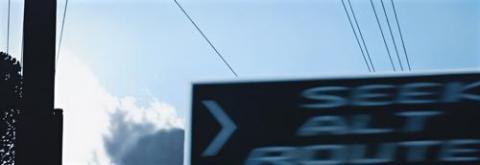SEEK ALTERNATIVE ROUTE #2, 2003
Andrew Browne
oil on linen
137.5 x 396.5 cm
signed, dated and inscribed with title verso: ANDREW BROWNE 2003/ ‘SEEK ALTERNATIVE ROUTE #2/ OIL ON LINEN
Kaliman Gallery, Sydney
Private collection, Melbourne
Andrew Browne: Paintings, Kaliman Gallery, Sydney, 15 May – 7 June 2003, cat.2 (label attached verso)
One of Australia's leading contemporary landscape painters, since 1981 Andrew Browne has held regular solo exhibitions in Sydney and Melbourne, participated in over fifty group shows including Black Attack, 1996 at the National Gallery of Victoria and Unpacked 2001 at the Museum of Contemporary Art, Sydney, and most notably, was honoured with a mid-career survey exhibition at the Bendigo Art Gallery, Painting Light, 1999. Indeed, reviewing his contribution to landscape painting in this country, critics have acclaimed him the heir of the Australian Impressionists with his abiding interest in the effects of light (although in Browne's case it tends to be artificial rather than natural) and his apparently unfazed acceptance of the way in which modern technologies have altered our understanding of the natural world. '...Just as Streeton and Roberts record, with a mixture of celebration and foreboding, the clearing of the Australian bush for pastoralism, so Andrew traces the post-industrial urbanisation of the land, seeming to enjoy the visual conundrums it throws up, while, at the same time, filling his pictures with a sense of gloom. It's that gloom, all those blankly impenetrable darknesses, along with the unspecific nature of the places he depicts (they could be anywhere) which is essentially romantic. What are those haloed car headlights coming to us out of the darkness but a modern manifestation of the sublime?'1
Thus oscillating between abstract pictorial construction and faithful portrayal, between romanticism and realism, Browne's mysterious, highly stylised paintings such as the present have won widespread recognition for the complex issues which they raise about selective vision and the nature of seeing. Although drawing inspiration from his continuing observation of the world through photography, his flawlessly painted images are far from the familiar or banal; to the contrary, in Browne's hands the ordinary becomes extraordinary as he skillfully blurs the distinction between landscape and mindscape. As Timms elucidates, his art '...says something important about the way we look at the environment, about the way our vision must always be selective, and why the distinctions we make between natural and man-made are no longer clear-cut and need to be rethought. When we look at the landscape through the window of a moving car, we may well see it selectively by mentally blocking out the road, the billboards and the light poles in order to appreciate the natural beauty of hills and trees. But, as Andrew's paintings remind us, when we do so we are creating an artifact: a nature of the mind.'2
1. Timms, P., 'Hauling Landscape Out Of The Woods', in Painting Light: Andrew Browne, Bendigo Art Gallery, Victoria, 1999, n.p.
2. ibid.
VERONICA ANGELATOS
